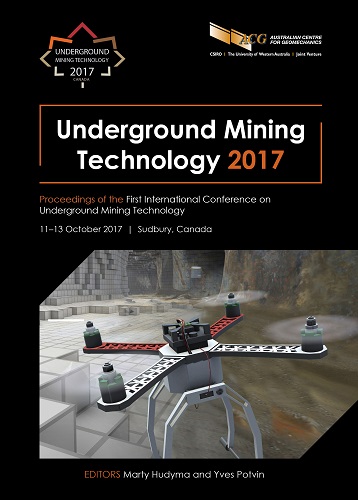Discrete simulations modelling the impact of operator numbers and truck availability on haulage fleet productivity

|
Authors: Shelswell, KJ; Labrecque, PO |
DOI https://doi.org/10.36487/ACG_rep/1710_57_Shelswell
Cite As:
Shelswell, KJ & Labrecque, PO 2017, 'Discrete simulations modelling the impact of operator numbers and truck availability on haulage fleet productivity', in M Hudyma & Y Potvin (eds), UMT 2017: Proceedings of the First International Conference on Underground Mining Technology, Australian Centre for Geomechanics, Perth, pp. 677-688, https://doi.org/10.36487/ACG_rep/1710_57_Shelswell
Abstract:
A discrete simulation was used to assess the impact of the number of haulage operators on the performance of truck haulage fleets. A dynamic simulation model was designed to quantify the productivity of an underground mine using diesel haulage trucks as prime movers in an operation with a single decline access. Truck haulage was simulated from load–haul–dump-serviced loadouts along the ramp and decline system to stockpile dump points on surface. The model was used to generate haulage productivity curves based on fleet size, operator crew size, and truck availability. These curves represent benchmark estimates for truck haulage operations to optimise crew planning based on historical and projected truck utilisation data.
Keywords: discrete event simulation, haulage productivity, truck utilisation, operator numbers
References:
Atkinson, T 1992, ‘Selection and sizing of excavating equipment’, in HL Hartman (ed.), SME Mining Engineering Handbook, Volume 2, 2nd edn, Society for Mining, Metallurgy, and Exploration, Littleton, pp. 1311–1333.
Bise, CJ 2003, Mining Engineering Analysis, Society for Mining, Metallurgy, and Exploration, Littleton.
Edwards, FA 1992, ‘Hoisting systems’, in HL Hartman (ed.), SME Mining Engineering Handbook, vol. 2, 2nd edn, Society for Mining, Metallurgy, and Exploration, Littleton, pp. 1646–1678.
Forbes, C, Evans, M, Hastings, N & Peacock, B 2011, Statistical Distributions, John Wiley and Sons Inc., Hoboken.
Gentry, DW 1976, ‘Development of deep mining techniques’, in GJS Govett & MH Govett (eds), World Mineral Supplies: Assessment and Perspective, Elsevier Scientific Publishing Company, Amsterdam, pp. 397–417.
Hirschey, M 2009, Managerial Economics, 12th edn, Cengage Learning, Mason.
Karnon, J, Stahl, J, Brennan, A, Caro, JJ, Mar, J & Möller, J 2012, ‘Modeling using discrete event simulation: a report of the ISPOR-SMDM Modeling Good Research Practices Task Force-4’, Value In Health, vol. 15, no. 6, pp. 821–827.
Moser, P 1996, ‘Primary development of underground hardrock mines’, in WT Hennies, LA Ayres da Silva & AP Chaves (eds), Mine Planning and Equipment Selection 1996, A.A. Balkema, Rotterdam, pp. 31–36.
Onyango, JP & Plews, AM 1987, A Textbook of Basic Statistics, East African Educational Publishers Ltd., Nairobi.
Robinson, S 2004, Simulation: The Practice of Model Development and Use, John Wiley and Sons Ltd., West Sussex.
Shelswell, KJ & Labrecque, PO 2014, ‘Discrete simulations quantifying the effects of material handling conveyors in series or parallel oreflow streams’, Proceedings of the 2014 SME Annual Meeting & Exhibit, Society for Mining, Metallurgy and Exploration, Littleton, pp. 444–446.
Yardley, ED & Stace, LR 2008, Belt Conveying of Minerals, Woodhead Publishing Limited, Cambridge.
© Copyright 2025, Australian Centre for Geomechanics (ACG), The University of Western Australia. All rights reserved.
View copyright/legal information
Please direct any queries or error reports to repository-acg@uwa.edu.au
View copyright/legal information
Please direct any queries or error reports to repository-acg@uwa.edu.au